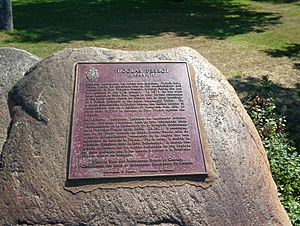Nicolas Perrot facts for kids
Quick facts for kids
Nicolas Perrot
|
|
|---|---|
 |
|
| Born | c. 1644 France
|
| Died | August 13, 1717 Bécancour, Quebec, New France
|
| Occupation | Explorer, fur trader, diplomat, interpreter |
| Spouse(s) | Madeleine Raclot |
| Children | 11 |
| Signature | |
 |
|
Nicolas Perrot (born around 1644–1717) was a brave French explorer, fur trader, and diplomat. He was one of the first Europeans to travel through the Upper Mississippi Valley. This area is now parts of Wisconsin and Minnesota in the United States.
Contents
Life of Nicolas Perrot
Nicolas Perrot was born in France, likely between 1641 and 1644. His father was a local judge.
Early Adventures in New France
Around 1660, Perrot sailed to New France (which is now Canada). He traveled with Jesuit missionaries. They went to the Great Lakes region in the west to meet and teach Native American tribes. By 1665, Perrot had reached what is now Wisconsin. He became friends with many Native American groups by trading furs for guns. This helped them protect themselves against their enemies. Because of his trading skills, he was called the "trafficker of iron" or "iron legs."
In 1667, Perrot started a fur trading business with three other people in Montreal. He returned to the Green Bay area later that year. In 1670, he worked as a translator for Simon-François Daumont de Saint-Lusson. Saint-Lusson was a French officer sent to claim lands around Lake Superior for King Louis XIV. This event was known as "The Pageant of the Sault."
Family Life and Important Roles
After his early travels, Nicolas Perrot married Madeleine Raclot. He received a piece of land along the Saint-Michel River in Quebec. By 1681, he and Madeleine had six children. They eventually had eleven children in total.
Perrot's strong relationships with western Native American tribes became very important in the 1680s. In 1684, he helped Governor Antoine Lefèbvre de La Barre on a peace mission. Perrot successfully brought warriors from different nations together to sign a peace treaty.
Peacemaker and Explorer
In the spring of 1685, Perrot was made Commandant-in-Chief of Bais Des Puants (which is now Green Bay, Wisconsin) and nearby areas. This happened when a war started between the Fox tribe and the Sioux and Chippewa tribes. Perrot worked hard to create peace between them, and he succeeded for a time. After this, Perrot explored the northern parts of the Mississippi River. In the land of the Sioux, he built Fort Saint Antoine, which is now in Minnesota.
In 1687, Perrot was in the Detroit area for an expedition. Sadly, a fire at the Jesuit mission in Bais Des Puants destroyed many of his furs. He lost a lot of money and was financially ruined. He went back to Montreal.
In 1688, Perrot served as a translator for a treaty between the French Governor and Otreouti, a chief of the Onondaga tribe. This treaty promised that the Onondaga, Cayuga, and Oneida tribes (part of the Haudenosaunee or Iroquois League) would stay neutral in conflicts with the French. In 1689, Perrot built Fort Saint-Pierre at the mouth of the Wisconsin River. He also helped establish peace among the tribes in that area.
Later Years and Legacy
In 1690, Perrot and Louis de la Porte de Louvigny led a very important supply convoy from Montreal to Michilimackinac. They managed to break through a blockade by the Iroquois. This helped resupply western Native American groups who were loyal to the French. Their success may have even saved New France. In the years that followed, Perrot also helped discover lead mines. Miami chiefs had told him about these mines.
In 1695, Perrot brought chiefs from the Miami, Sauk, Menominee, Potawatomi, and Fox tribes to Montreal. The governor had asked for this meeting because of a war with the Iroquois. Perrot returned west. He worked to keep these tribes united and peaceful in their fight against the Iroquois. However, his life was often in danger. Twice, he was almost captured and burned by the Mascouten and Miami tribes.
Perrot eventually settled on his land in Bécancour, Quebec. The Native American chiefs he knew saw him for the last time in 1701 at the Great Peace of Montreal. He continued to work as a translator. However, this time in his life was difficult due to money problems and people he owed money to. He asked the government for money he felt he was owed and a pension for his long service, but he did not receive them. He also wrote down his memories, which later became very valuable to historians.
Nicolas Perrot passed away on August 13, 1717, at about 74 years old. He was buried the next day in the church at Bécancour, Quebec. Nine of his eleven children lived longer than him. His wife died in 1724.
Perrot State Park, located near the Trempealeau River and Mississippi River in Wisconsin, is named after him.


